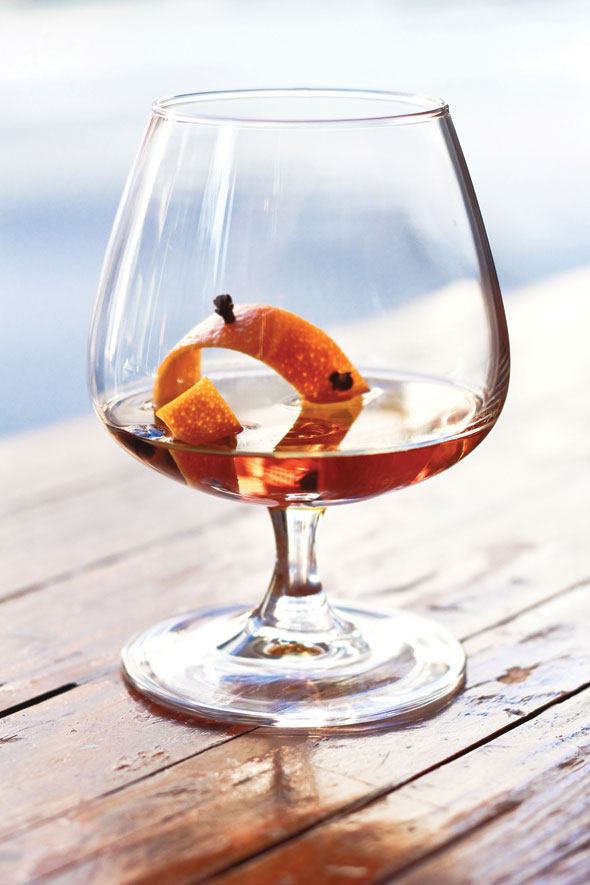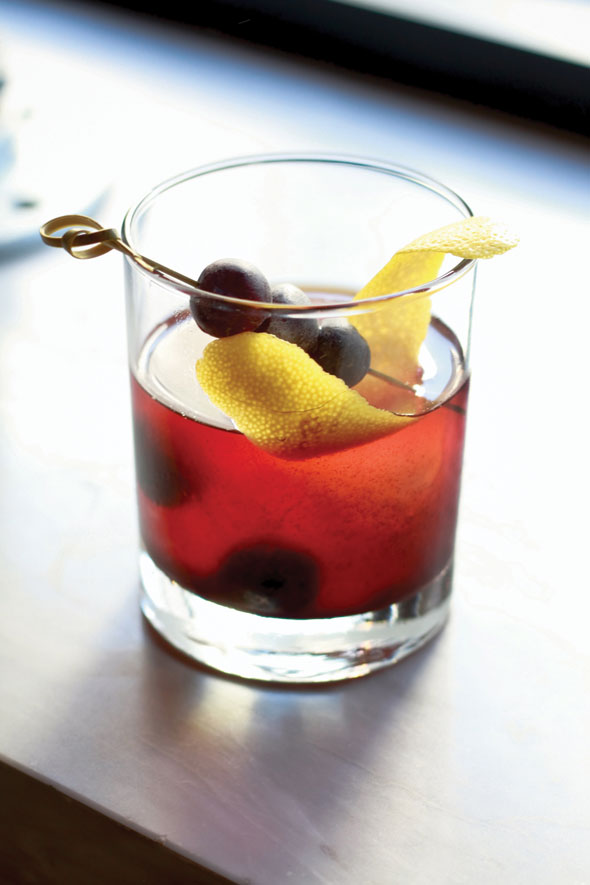Socially speaking, the cocktail is king. Few common customs will entrance and cause obsession in the manner of a properly mixed drink. Urbanites throughout the world scour their cities for the best Old Fashioned, the finest Last Word, often to realize beauty is in the eye of the beholder. There are rules, but none have been set in stone. The cocktail and its blueprint continually change on the whims of the bartender and those lucky enough to imbibe. A drink’s pedigree serves as a backbone, but a cocktail’s current state depends on the creator and a captive audience.

Toddy Azul
Toddy Azul
1.5 oz Clase Azul Plata Tequila
.25 oz (or slightly less than) Fire Lit Coffee Liqueur
Dried cloves
Orange Rind
2 Coffee Beans
Begin by heating a snifter and pierce a long cut of orange rind with 4 to 5 cloves. Pour the Tequila and Coffee liqueur into the heated glass and pinch the orange rind, relieving some of the oil over the glass and drop the rest in. Finish off with a pair of coffee beans.
The art of imbibing has a history winding back to the beginnings of the New World. The name ‘Cocktail’ remains shrouded in mystery, muddied by many an entertaining anecdote. From hundreds of tales one may date the name’s origin to the end of the 18th century. By 1806, the cocktail was officially defined. In response to an inquisitive reader, the American publication Balance and Columbian Repository published: “A ‘Cocktail’ is a stimulating liquor composed of spirits of any kind, sugar, water, and bitters…It is vulgarly called a “bittered sling.” The word itself has been affixed to many an origin, some are joyous, others might be unsavory, but all are colorful. The word Cocktail was most likely created from a phrase. Which historical phrase, however, is still up for debate. Perhaps the name arrived from the English and their term “cock-tailed,” a horse of a mixed, non- thoroughbred nature; spirits when mixed were likened to this type of beast. Possibly the “Cocktail” came from down Mexico way through a translation of the phrase Cola de Gallo. In English, Cola de Gallo becomes the phrase “Cock’s Tail.” English sailors down on the Yucatán peninsula witnessed drinks being stirred with a Cola de Gallo, a type of plant root in the 20th century. The sailors renamed what was known before as a “drac” to what would now be known as a “cocktail.” Who is to say which colorful story holds the truth. The best things in life always involve a little myth, a bit of mystery, and are continuously surrounded by a great many tales.

Waistcoat and Tar
Waistcoat and Tar
1.5oz Pimm’s No. 1
1oz Templeton Rye
4 Concord Grapes
1 slice lemon
2 shakes Peychaud’s Bitters
Place the grapes, lemon and Peychaud’s Bitters into a mixing glass. Muddle and mix the rest of the ingredients. Stir until cold and double strain into a double rocks glass. Drop in a large ice cube and garnish with a twist.
By itself, a “cocktail” is nothing but an idea, perhaps a vague notion of many ingredients brought together in one glass. Only when entrusted to certain individuals does this abstract idea take shape. From it’s inception, the mixed drink has been hoisted onto the backs of many a talented bon vivant. The first book of cocktail recipes was published by Jerry Thomas in 1862. This book was appropriately entitled How To Mix Drinks, or The Bon Vivant’s Companion. Thomas’ publication brought together, for the first time, a patchwork of recipes known throughout the country. Recipes for Toddies, Flips, Cobblers, and Sours were all included, all of which are still prevalent today. The art of mixing drinks was firmly in place. By the 1890’s, from New Orleans to San Francisco, “The Golden Age of Cocktails” was in full swing. Cocktails and there creators would remain popular all the way up to the onset of prohibition.
The laws of prohibition would usher in a new era for the art of mixing drinks. Many of the most talented mixologists would pack their tools and ‘know-how’ and set off for more accommodating shores. Prohibition did not kill the cocktail in America, but it was driven underground. The quality of spirits was severely affected and drinks were often mixed out of necessity and not pure pleasure. Abroad, however, creativity and craft was alive and well. Harry Craddock would capture all the gems of the day in his seminal collection of recipes, The Savoy Cocktail Book. This assemblage of cocktails has arguably become the most influential recipe book to date. Many of today’s bartenders return time and again to this work for guidance and inspiration.

Pillow Talk
Pillow Talk
2 oz Campo De Encanto Pisco
1.25 oz Spiced Quince Syrup
.50 oz Lemon Juice
.25 oz Velvet Falernum
3 drops splash of Peychaud’s Bitters
One egg white
Combine all ingredients in a shaker cup, dry shake and then add ice. Shake once more, with ice this time and strain the ingredients into a large coupe glass. Dash a small amount of bitters over the top and garnish with a single rose petal.
The cocktail was welcomed back to the shores of America, on December 5, 1933 with open arms and great fanfare.
With the return of mixed drinks a sense of novelty and fun would edge itself in where craft and sophistication once were. Many began to mix their own libations and become amateur mixologists, operating from home bars in the comfort of their living rooms. This is not to say that the art of mixing drinks had been forgotten, as there were still many a fine establishment crafting libations, but a particular sophistication that had once existed now seemed to be lost. The post-depression, post-war years saw the cocktail become simplified in many ways. Martini’s and Highballs were the darling’s of the day. This time of simplicity had one particular exception. Victor Bergeron, of Trader Vic’s fame, would search near and far, sourcing exotic ingredients to mix into his ‘Tiki Drinks.’ His books and restaurants would give rise to a whole new genre of cocktails, which to this day still have a cult following. He is a shining light in a somewhat dim point cocktail history.

Dolly’s Dagger
Dolly’s Dagger
1oz Bombay Gin
1oz Dolin Dry Vermouth
.25 Hibiscus
.25 Lemon
4 drops Kübler Absinthe
Campari dusted rim
Place gin, vermouth, hibiscus syrup, and lemon in a mixing glass and add ice. Stir until very cold and strain into small coupe, that has been rimmed with dry Campari/Sugar dust. With an eyedropper, add four drops of Kübler Absinthe on top of the cocktail.
Today, we have come full circle. The cocktail is again surrounded by sophistication and craft. Interest in forgotten drinks, mixers, and spirits have all fueled a resurgence in an art all but lost. A handful of bartenders have sparked a movement that supersedes any prior in creativity and precision. Modern day bon vivants such as Gary Regan and N.Y.C’s Dale Degroff have spearheaded a renewed interest in the cocktail and the manner in which it is made. A new golden age is upon us, bartenders from all over the world are breaking new ground and putting together ingredients never before combined. From city to city, followers of the cocktail search out bars and restaurants for the latest innovation, the new twist, the most divine drink. Here, in the following pages is a taste of what is to be found, an offering of cocktails to obsess over.
Mixed by Gabriel Cothes
Cocktail Director at the Salt House San Francisco

